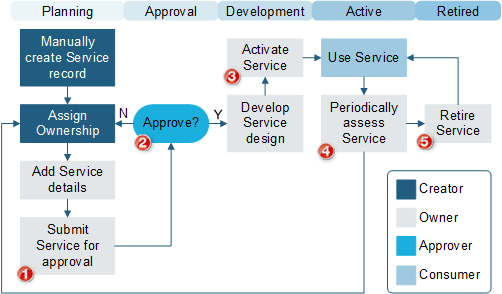Service Workflow
Diagram describes the high-level Service workflow in the OOTB system.

| 1 | A One-Step™ Action changes the status to Approval. |
| 2 |
The Approver can approve or reject a Service.
|
| 3 | A One-Step Action changes the status to Active. The Service is now available to users and customers. |
| 4 |
When periodically assessing, the Owner can revise or retire a Service.
|
| 5 | When retired, the Owner can reactive a Service. A One-Step Action changes the status back to Active. |
- CSM uses several features to enhance the Service workflow (example: The Service Form helps create and manage Services, One-Step Actions help move a Service through its workflow, etc.).
- Service phases align with Service statuses, but this is not the case in every process (example: Incident phases are different than Incident statuses).
Contributors
A Service typically involves the following contributors. Depending on your workflow and the size of your company, many of these contributors might be combined into one person (example: Creator and Owner might be the same person).
- Creator: User who creates the Service. This is typically a member of the Services Team.
- Owner: User who manages the Service. This is typically a member of the Services Team.
- Approver: User who ensures that the Service is ready to be released and made operational in a live environment. This is typically the Service/IT Manager.
- Consumer: Person who uses the Service. This is typically a customer or user logging a record.
Phases
The Service workflow is broken down into the following phases:
- Planning: Creator creates a new Service. Ownership is assigned. Then, the owner designs the Service and submits it to an Approver for approval to develop.
- Approval: Approver approves the Service for development. The Approver can also reject the Service and send it back for rework.
- Development: Owner defines categories and subcategories for the Service. When ready, the Owner releases/activates the Service.
- Active: Service is operational in a live environment. The Service is periodically assessed by the Owner. The Service can be sent back for review/rework or be retired if necessary.
- Retired: Expired/out-of-date Service is retired. The Service can be reactivated, if necessary.